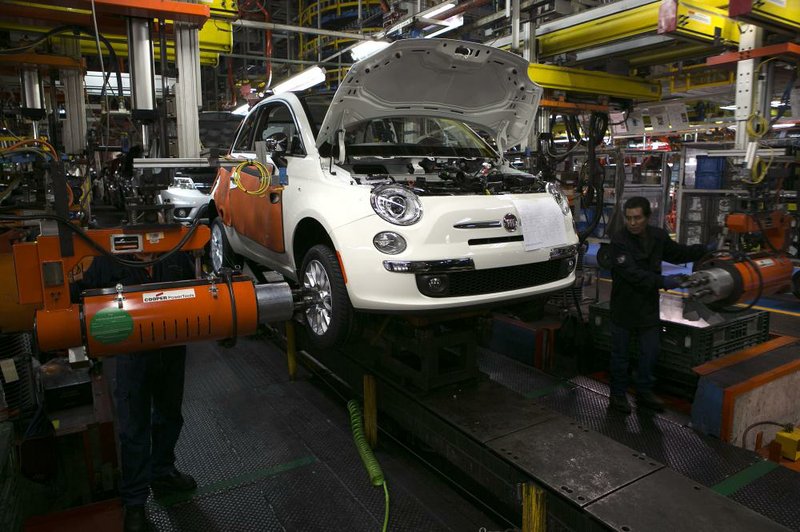Sergio Marchionne’s five year effort to merge Fiat SpA and Chrysler Group LLC culminated in a Florida beach town, where the workaholic chief executive officer spent hours nailing a deal announced New Year’s Day.
The 61-year-old Italianborn Canadian, who juggles running the two manufacturers with the help of six mobile devices, traveled Saturday to Vero Beach, Fla., for the decisive meeting with a United Auto Workers healthcare trust.
There, Marchionne struck a deal to buy the 41.5 percent stake in Chrysler held by the UAW trust. The agreement gives Fiat full control of the No. 3 U.S. carmaker, allowing it to better compete with the likes of General Motors Co. and Volkswagen AG. It’s the biggest deal in the auto industry since Volkswagen agreed to combine with Porsche in 2009.
The $4.35 billion deal marks a “historic moment for both Fiat and Chrysler,” Marchionne said in a joint letter to employees with Fiat Chairman John Elkann that refers to the “emotion” of seeing years of work come to fruition. “The result has been the creation of a global automaker that is among the leaders in the sector.”
The agreement will cost the Turin-based company about a 10th the amount that then-Daimler-Benz AG paid for Chrysler 15 years ago. Auburn Hills, Mich.-based Chrysler will pick up much of the tab, protecting Fiat’s cash reserves and sending the Italian company’s stock up 16 percent. The deal will allow Marchionne to pool Chrysler’s cash with Fiat’s and better integrate the Fiat, Alfa Romeo and Maserati brands with Chrysler, Jeep and Dodge.
“Marchionne clearly spent his Christmas holiday working harder than we did,” said Max Warburton, an analyst with Bernstein Research in Singapore. “The most surprising aspect of all is the source of funding - over 50 percent of the upfront cash will come from Chrysler.”
Marchionne has made a combination of Fiat and Chrysler a personal mission. The right to resurrect the American manufacturer after its 2009 bankruptcy gave him a “huge sense of responsibility,” Marchionne said in 2011. Since then, Fiat built up a 58.5 percent holding, leaving the trust’s stake the last piece of the pie.
Being trusted with reviving an American icon is “something that happens to you once in a lifetime,” he said in his office in Fiat’s Turin headquarters, which was adorned with a black- and-white poster of the word “competition” and a print from Pablo Picasso that bears the motto “every act of creation is first of all an act of destruction.”
When Marchionne took the helm of Fiat in 2004, the Italian company was on the brink of bankruptcy after losing more than $8.2 billion from 2001 to 2003. He managed to return the company to profit in 2005, helped by wringing $2 billion from GM to end a failed alliance.
While a merger with Chrysler would make Fiat the world’s seventh-largest carmaker and give it better scale to compete with GM, Volkswagen and Toyota Motor Corp., the combined company still needs a bigger presence in the growth markets of Asia and has to prove it can make money in Europe.
The final push for the Chrysler breakthrough started with Fiat making a revised offer to the union trust at a Detroit meeting on Dec. 19, according to four people familiar with the matter who requested not to be identified because the talks were private. The sides had been deadlocked for months, with the trust seeking at least $5 billion.
Fiat’s board in Turin then considered a counterbid from the trust, which had lowered its expectations on concerns that the U.S. auto market was peaking, one person said. With the two sides getting closer, Marchionne requested a meeting with the fund’s advisers, including Alain Lebec, senior managing director of Brock Capital LLC. That meeting took place at Lebec’s residence in Vero Beach, a resort town on the Atlantic coast, two people said.
The trust and Marchionne, a self-described corporate “fixer,” agreed to a price between the final two proposals at Saturday’s meeting that lasted roughly four hours past sunset. The next day, Fiat’s board approved the agreement and final details were worked out until the surprise announcement Wednesday.
The outcome means Fiat will fork out about $3.7 billion in cash for total control of Chrysler, helping it gain access to the resurgent American carmaker’s $12 billion in reserves to help fund a turnaround in Fiat’s unprofitable European business. The Italian company’s investment compares with the $36 billion that Daimler paid for the company in 1998.
“Marchionne showed he’s a real maestro,” said Giuseppe Berta, a professor at Bocconi University in Milan who has written several books on Fiat. “Now the merger of Fiat and Chrysler is a done deal.”
A time line for the combination may be outlined later this month, when Fiat’s board meets, said two people familiar with the situation. That might cut down on Marchionne’s travel, which included frequent trans-Atlantic flights.
Business, Pages 23 on 01/03/2014
